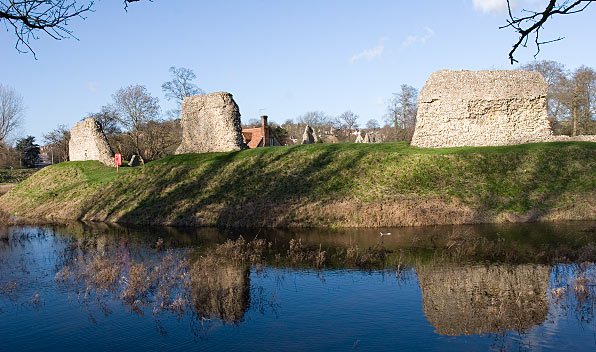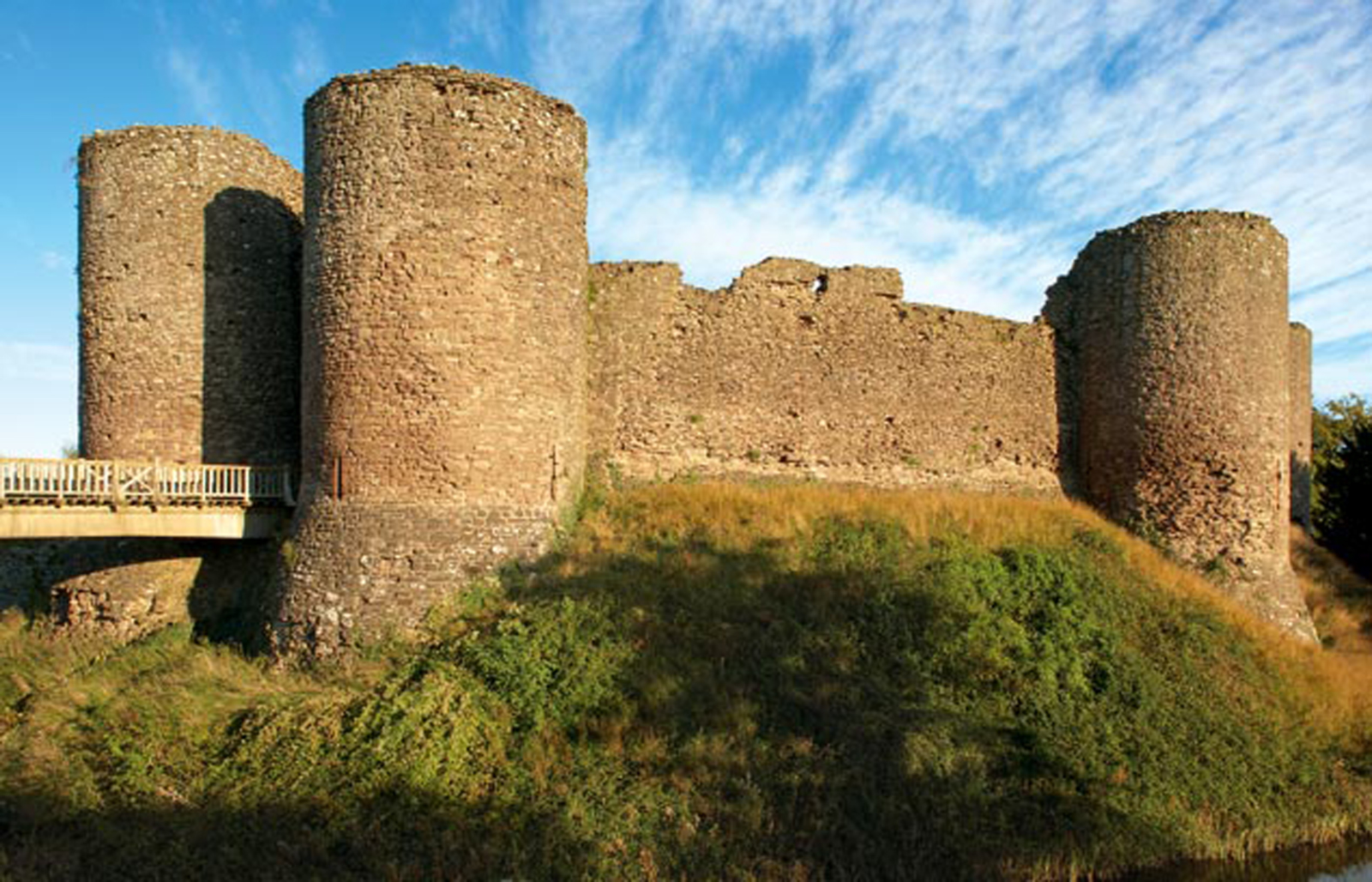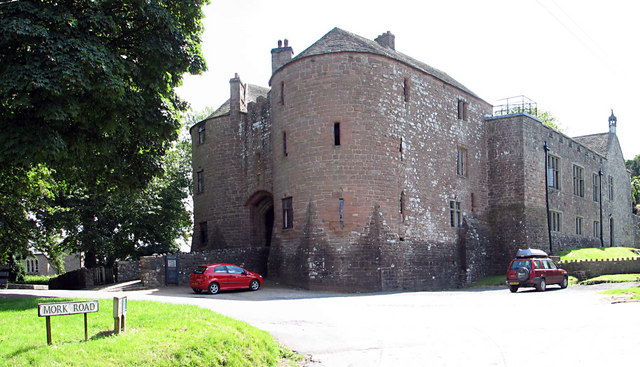|
Hugh Waterton
Sir Hugh Waterton, (born circa 1340 efore 1373– died 2 July 1409) was a trusted servant of the House of Lancaster. Family Waterton's date of birth is not known. Some would have it, he was the second son of William Waterton of Waterton, Lincolnshire, and Elizabeth Newmarch, the daughter of Sir Roger Newmarch of Womersley, Yorkshire, by his wife, Maud.A Hugh Waterton, Esq. is known who was a young man in 1386, knighted by 1398, d.1409, born son of William Waterton by his wife, daughter and heiress of Thomas Methley of Methley, near Wakefield, Yorkshire; He had an elder brother, John Waterton, and was uncle to Robert Waterton, another lifelong Lancastrian servant. Career Waterton served in France in 1373 with John of Gaunt, 1st Duke of Lancaster and became his attorney. By 1375 he had acquired the manor of Eaton Tregoz near Ross-on-Wye in Herefordshire, which by an inquisition taken after his death was found to contain castle buildings and a deer park of 144 acres. [...More Info...] [...Related Items...] OR: [Wikipedia] [Google] [Baidu] |
House Of Lancaster
The House of Lancaster was a cadet branch of the royal House of Plantagenet. The first house was created when King Henry III of England created the Earldom of Lancasterfrom which the house was namedfor his second son Edmund Crouchback in 1267. Edmund had already been created Earl of Leicester in 1265 and was granted the lands and privileges of Simon de Montfort, 6th Earl of Leicester, after de Montfort's death and attainder at the end of the Second Barons' War. When Edmund's son Thomas, 2nd Earl of Lancaster, inherited his father-in-law's estates and title of Earl of Lincoln he became at a stroke the most powerful nobleman in England, with lands throughout the kingdom and the ability to raise vast private armies to wield power at national and local levels. This brought himand Henry, his younger brotherinto conflict with their cousin King Edward II, leading to Thomas's execution. Henry inherited Thomas's titles and he and his son, who was also called Henry, gave loyal service ... [...More Info...] [...Related Items...] OR: [Wikipedia] [Google] [Baidu] |
Hay-on-Wye
Hay-on-Wye ( cy, Y Gelli Gandryll), simply known locally as "Hay" ( cy, Y Gelli), is a market town and community in Powys, Wales; it was historically in the county of Brecknockshire. With over twenty bookshops, it is often described as "the town of books"; it is both the ''National Book Town of Wales'' and the site of the annual Hay Festival. The population of the town in 1841 was 1,455; this had grown to 1,680 by 1901. The town has grown little since, with 2018 estimates at 1,900. The built-up area includes Cusop across the border in England and has a population of around 2,000. Location The town lies on the south-east bank of the River Wye and is within the north-easternmost tip of the Brecon Beacons National Park, just north of the Black Mountains. The town is just on the Welsh side of the border with Herefordshire, England, here defined by the Dulas Brook. Where the brook joins the River Wye just north of the town, the border continues northwards along the river. The Wy ... [...More Info...] [...Related Items...] OR: [Wikipedia] [Google] [Baidu] |
Skenfrith
Skenfrith ( cy, Ynysgynwraidd) is a small village in Monmouthshire, south-east Wales. It is located on the River Monnow, close to the border between Wales and England, about north-west of Monmouth. The road through the village (B4521) was once the A40, linking Ross-on-Wye and Abergavenny. History and amenities The Welsh placename ''Ynysgynwraidd'', from which the English name derives, means "island of Cynfraeth", possibly a local 6th century leader. Skenfrith Castle is one of the Three (or 'trilateral') Castles – with Grosmont Castle and White Castle – built in the area after the Norman conquest by Marcher Lords to subjugate and dominate this part of the turbulent Welsh Marches into the medieval period. The castle was substantially rebuilt by Hubert de Burgh between 1219 and 1223, but by 1538 it was abandoned and in ruins. St. Bridget's Church, Skenfrith was first mentioned in 1207, and was reconstructed and enlarged in the 14th century. The church has a squat tower ... [...More Info...] [...Related Items...] OR: [Wikipedia] [Google] [Baidu] |
White Castle, Wales
White Castle ( cy, Castell Gwyn), also known historically as Llantilio Castle, is a ruined castle near the village of Llantilio Crossenny in Monmouthshire, Wales. The fortification was established by the Normans in the wake of the invasion of England in 1066, to protect the route from Wales to Hereford. Possibly commissioned by William fitz Osbern, the Earl of Hereford, it comprised three large earthworks with timber defences. In 1135, a major Welsh revolt took place and in response King Stephen brought together White Castle and its sister fortifications of Grosmont and Skenfrith to form a lordship known as the "Three Castles", which continued to play a role in defending the region from Welsh attack for several centuries. King John gave the castle to a powerful royal official, Hubert de Burgh, in 1201. Over the next few decades, it passed back and forth between several owners, as Hubert, the rival de Braose family, and the Crown took control of the property. During this perio ... [...More Info...] [...Related Items...] OR: [Wikipedia] [Google] [Baidu] |
Grosmont Castle
Grosmont Castle is a ruined castle in the village of Grosmont, Monmouthshire, Wales. The fortification was established by the Normans in the wake of the invasion of England in 1066, to protect the route from Wales to Hereford. Possibly commissioned by William fitz Osbern, the Earl of Hereford, it was originally an earthwork design with timber defences. In 1135, a major Welsh revolt took place, and in response King Stephen brought together Grosmont Castle and its sister fortifications of Skenfrith and White Castle to form a lordship known as the "Three Castles", which continued to play a role in defending the region from Welsh attack for several centuries. King John gave the castle to a powerful royal official, Hubert de Burgh, in 1201. During the course of the next few decades it passed back and forth between several owners, including Hubert, the rival de Braose family, and the Crown. Hubert rebuilt the castle in stone, beginning with a new hall and then, on regaining the p ... [...More Info...] [...Related Items...] OR: [Wikipedia] [Google] [Baidu] |
Monmouth
Monmouth ( , ; cy, Trefynwy meaning "town on the Monnow") is a town and community in Wales. It is situated where the River Monnow joins the River Wye, from the Wales–England border. Monmouth is northeast of Cardiff, and west of London. It is within the Monmouthshire local authority, and the parliamentary constituency of Monmouth. The population in the 2011 census was 10,508, rising from 8,877 in 2001. Monmouth is the historic county town of Monmouthshire although Abergavenny is now the county town. The town was the site of a small Roman fort, Blestium, and became established after the Normans built Monmouth Castle . The medieval stone gated bridge is the only one of its type remaining in Britain. The castle later came into the possession of the House of Lancaster, and was the birthplace of King Henry V in 1386. In 1536, it became the county town of Monmouthshire. A market town and a focus of educational and cultural activities for the surrounding rural area, Monmouth ... [...More Info...] [...Related Items...] OR: [Wikipedia] [Google] [Baidu] |
St Briavels Castle
St Briavels Castle is a moated Norman castle at St Briavels in the English county of Gloucestershire. The castle is noted for its huge Edwardian gatehouse that guards the entrance. St Briavels Castle was originally built between 1075 and 1129 as a royal administrative centre for the Forest of Dean. During the 13th century the castle became first a favourite hunting lodge of King John, and then the primary centre in England for the manufacture of quarrels, large numbers of which were required for crossbows in medieval warfare. The castle was transferred many times between royal favourites in the 14th and 15th centuries and slowly declined in appearance and importance. St Briavels Castle became used primarily as a court and as a notorious debtors' prison, conditions being documented by the prison reformer John Howard in 1775. Following local riots and a parliamentary investigation in the 1830s, reforms in the 19th century brought an end to the castle's use as a prison. Extensive ... [...More Info...] [...Related Items...] OR: [Wikipedia] [Google] [Baidu] |
Thomas De Mowbray, 1st Duke Of Norfolk
Thomas de Mowbray, 1st Duke of Norfolk, KG (22 March 136622 September 1399) was an English peer. As a result of his involvement in the power struggles which led up to the fall of King Richard II, he was banished and died in exile in Venice. Background and youth The Mowbrays were an old family in the English peerage, having been first raised to the baronage in 1295. Several advantageous marriages, combined with loyal service to the crown and rewards from it made them, by the late 14th century, a great political standing. Thomas was the son of John de Mowbray, 4th Baron Mowbray and his wife Elizabeth Segrave, the daughter and heiress of John Segrave, 4th Baron Segrave by his wife Margaret, Duchess of Norfolk, daughter and heiress of Thomas of Brotherton, 1st Earl of Norfolk, the fifth son of King Edward I. Thomas Mowbray was born in 1366; the precise date is unknown. He was probably named after the cult of St Thomas Becket, of which his mother was a follower. His elder brothe ... [...More Info...] [...Related Items...] OR: [Wikipedia] [Google] [Baidu] |
Thomas De Mowbray, 4th Earl Of Norfolk
Thomas de Mowbray, 4th Earl of Norfolk, 2nd Earl of Nottingham, 8th Baron Segrave, 7th Baron Mowbray (17 September 1385 – 8 June 1405), English nobleman and rebel, was the son of Thomas de Mowbray, 1st Duke of Norfolk, and Lady Elizabeth FitzAlan. Upon the death of his father in Venice, he succeeded him as Earl of Norfolk and Nottingham, but not as Duke of Norfolk. He also received his father's title of Earl Marshal, but on a strictly honorary basis, the military rank being held by Ralph Neville, 1st Earl of Westmorland, as the Marshal of England. He was betrothed to Constance Holland, daughter of John Holland, 1st Duke of Exeter, then a child, but the marriage was never consummated. He became involved with the latest rebellion of the Percies in the north, and raised an army with Richard le Scrope, Archbishop of York. Deserted by the Earl of Northumberland, Norfolk and Scrope were brought to book on Shipton Moor by a large royal army under John of Lancaster and the Earl ... [...More Info...] [...Related Items...] OR: [Wikipedia] [Google] [Baidu] |
Chepstow Castle
Chepstow Castle ( cy, Castell Cas-gwent) at Chepstow, Monmouthshire, Wales is the oldest surviving post-Roman stone fortification in Britain. Located above cliffs on the River Wye, construction began in 1067 under the instruction of the Norman Lord William FitzOsbern. Originally known as Striguil, it was the southernmost of a chain of castles built in the Welsh Marches, and with its attached lordship took the name of the adjoining market town in about the 14th century. In the 12th century the castle was used in the conquest of Gwent, the first independent Welsh kingdom to be conquered by the Normans. It was subsequently held by two of the most powerful Anglo-Norman magnates of medieval England, William Marshal and Richard de Clare. However, by the 16th century its military importance had waned and parts of its structure were converted into domestic ranges. Although re-garrisoned during and after the English Civil War, by the 1700s it had fallen into decay. With the later gr ... [...More Info...] [...Related Items...] OR: [Wikipedia] [Google] [Baidu] |
Duchy Of Lancaster
The Duchy of Lancaster is the private estate of the Monarchy of the United Kingdom, British sovereign as Duke of Lancaster. The principal purpose of the estate is to provide a source of independent income to the sovereign. The estate consists of a portfolio of lands, properties and assets held in trust for the sovereign and is administered separately from the Crown Estate. The duchy consists of of land holdings (including rural estates and farmland), urban developments, historic buildings and some commercial properties across England and Wales, particularly in Cheshire, Staffordshire, Derbyshire, Lincolnshire, Yorkshire, Lancashire and the Liberty of the Savoy, Savoy Estate in London. The Duchy of Lancaster is one of two duchies in England, royal duchies: the other is the Duchy of Cornwall, which provides income to the Duke of Cornwall, a title which is traditionally held by the Prince of Wales. As of the financial year ending 31 March 2022, the estate was valued at £652.8 mill ... [...More Info...] [...Related Items...] OR: [Wikipedia] [Google] [Baidu] |
Justice Of The Peace
A justice of the peace (JP) is a judicial officer of a lower or ''puisne'' court, elected or appointed by means of a commission ( letters patent) to keep the peace. In past centuries the term commissioner of the peace was often used with the same meaning. Depending on the jurisdiction, such justices dispense summary justice or merely deal with local administrative applications in common law jurisdictions. Justices of the peace are appointed or elected from the citizens of the jurisdiction in which they serve, and are (or were) usually not required to have any formal legal education in order to qualify for the office. Some jurisdictions have varying forms of training for JPs. History In 1195, Richard I ("the Lionheart") of England and his Minister Hubert Walter commissioned certain knights to preserve the peace in unruly areas. They were responsible to the King in ensuring that the law was upheld and preserving the " King's peace". Therefore, they were known as "keepers of th ... [...More Info...] [...Related Items...] OR: [Wikipedia] [Google] [Baidu] |






.jpg)
